Marilia Kranz 1937-2017
Marília Kranz was born and lived in the city of Rio de Janeiro, whose landscape is a
recurring subject in her work. Having drawn since childhood, at the age of 17 she began
her formal studies in art, studying painting at the Museum of Modern Art in Rio de
Janeiro. In 1956, she joined the National School of Fine Arts, where she studied for
three years. She also attended the studios of Catarina Baratelli (painting, 1963-66) and
Eduardo Sued (engraving, 1971).
In the early stage of her production, until the mid-1960s, Kranz focused on drawing
and the study of painting. Afterwards, she began to produce abstract reliefs in plaster,
cardboard, and wood – works that were part of her first solo exhibition, in 1968, at Oca
Gallery, in Rio de Janeiro. In 1969, after returning from trips to Europe and the United
States, she started to produce reliefs using the vacuum forming technique with rigid
polyurethane, fiberglass, resin, and industrial enamels; as well as sculptures with cut
and polished acrylic, called Contraforms.
Kranz innovated by producing frame-objects using the vacuum forming technique,
which was not widespread in Brazil at the time, even in the industrial sector. In
addition, the content of the works also had a strong experimental character. According
to art critic Frederico Morais, the abstract and geometric forms explored in these works
and in Marília's entire body of work would be closer to artists such as Ben Nicholson,
Auguste Herbin, and Alberto Magnelli than to the constructivist trends that were
prominent in Brazil, such as Concretism and Neo-concretism.
From 1974 on, Kranz resumed her painting practice, addressing in her canvases
elements of her favorite landscapes in Rio de Janeiro. Compared to artists such as
Giorgio de Chirico and Tarsila do Amaral, her geometrized landscapes and figures,
bordering on abstraction, contain solemnity and eroticism at the same time. Pastel
tones, in turn, became her signature. "The color surrenders before the luminous
intensity," says Frederico Morais. When we look at the flowers and fruits that are
featured in several of her paintings with great sensuality, we also think of Georgia
O'Keeffe, considered by Kranz as her "soul sister".
The artist is also known for her support of women's sexual liberation and political
freedom during the military dictatorship in Brazil, as well as her fight for environmental
causes, being one of the founders of the Partido Verde in 1986.
Marília Kranz has held exhibitions in galleries and national and international institutions
and has received numerous awards for her paintings and sculptures, including: the
sculpture award at the 13o Panorama de Arte Atual Brasileira, in 1981, and the
acquisition prize at the Salão de Artes Visuais do Estado do Rio, in 1973. In 2007, there
was the retrospective exhibition Marília Kranz: reliefs and sculptures at the Museum of
Modern Art in Rio de Janeiro, the occasion when the monograph Marília Kranz was
launched, written by the art critic Frederico Morais, who followed the artist during her
entire career.
-

O Spleen e a flor
Galeria Martins&Montero | São Paulo – SP 30 Oct 2025 - 24 Jan 2026Read more -

Todas as mulheres do mundo
curated by: Gabriela Mexias | BNPP's head office 26 Jan - 31 Mar 2024Read more -

Distorção Material: KURA e Lucas Recchia
collaboration between: KURA and Lucas Recchia 22 Nov - 2 Dec 2023Read more -

Marilia Kranz: reliefs and paintings
Critical Essay: Fernanda Morse 8 Mar - 29 Apr 2023 Galatea Oscar FreireMarilia Kranz: passionate as a carioca postcard Fernanda Morse Union and geometry: protrusion, grooves fit together, volumes interpenetrate. Marks and bodies in relief, a constructive in permanence on the realm...Read more
-

ArtRio 2025
10 - 14 Sep 2025Galatea is pleased to participate in the 15th edition of ArtRio , taking place from September 10th to 14th at Marina da Glória, in Rio...Read more -

SP-Arte 2025
2 - 6 Apr 2025Galatea is pleased to announce its participation at the SP–Arte 2025 fair, which will take place at the Bienal Pavilion, in Ibirapuera Park, from April...Read more -

ArtRio 2024
25 - 29 Sep 2024The Galatea booth at ArtRio 2024 presents a selection of works that reflects its artistic program. Showcasing a range of artists, from emerging talents on...Read more -

SP-Arte 2024
3 - 7 Apr 2024Galatea is pleased to announce the participation in SP–Arte 2024, taking place at the Bienal Pavilion from April 3 to April 7, 2024. At our...Read more







